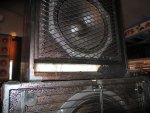Re: B&C Sub designs
Alan,
I think your math converting sq cm into sq inches must be off. When I converted 339 sq cm into inches I came up with a port that would be 7.255 inches x 7.255 inches = 52.6 square inches. 1sq cm = 0.155 sq in. 339.6 * 0.155 = 52. Make it whatever shape you want just keep the area at 52.6 and the Fb at 32. Your program should give you a port length pretty close to 12.5 inches. If you just model the B&C design as a 200 liter box with Fb of 32 with 52.6 sq in port area you will I'm sure come up with the F3 of 32.2 that B&C shows on their page.
And I'll bet that when you look at the B&C recommended enclosure excursion predictions in your software you will find it might exceed excursion limits in the 45 to 55 range if driven with max power. That is what I was trying to say in my previous posts. So getting the extra LF extension will cost you some power handling 1/2 octave above Fb because you will run out of excursion. But remember this driver has Xmax of 12mm and Xvar of 14mm. Xvar is apparently a more accurate parameter than traditional Xmax for reflecting how much excursion a driver can really provide prior to excessive distortion. So the usable excursion is really 14mm. Further, the driver has 28.5mm one way excursion before damage so even if linear excursion capability is exceeded at some frequencies at very high power you are unlikely to ever hurt the driver with overexcursion as long as you don't use any stupid EQ boosts and do use an appropriate hpf.
With that said, I understand that you purposely came up with a design that wouldn't exceed Xmax in the passband. That is a reasonable trade off, but I think that a design for this driver with lower Fb and F3 would handle all the power you want in the real world (up to thermal limits) and not hurt the driver but still give you extra LF extension. It's all about trade offs.
Does that make sense?
Loren
Alan,
I think your math converting sq cm into sq inches must be off. When I converted 339 sq cm into inches I came up with a port that would be 7.255 inches x 7.255 inches = 52.6 square inches. 1sq cm = 0.155 sq in. 339.6 * 0.155 = 52. Make it whatever shape you want just keep the area at 52.6 and the Fb at 32. Your program should give you a port length pretty close to 12.5 inches. If you just model the B&C design as a 200 liter box with Fb of 32 with 52.6 sq in port area you will I'm sure come up with the F3 of 32.2 that B&C shows on their page.
And I'll bet that when you look at the B&C recommended enclosure excursion predictions in your software you will find it might exceed excursion limits in the 45 to 55 range if driven with max power. That is what I was trying to say in my previous posts. So getting the extra LF extension will cost you some power handling 1/2 octave above Fb because you will run out of excursion. But remember this driver has Xmax of 12mm and Xvar of 14mm. Xvar is apparently a more accurate parameter than traditional Xmax for reflecting how much excursion a driver can really provide prior to excessive distortion. So the usable excursion is really 14mm. Further, the driver has 28.5mm one way excursion before damage so even if linear excursion capability is exceeded at some frequencies at very high power you are unlikely to ever hurt the driver with overexcursion as long as you don't use any stupid EQ boosts and do use an appropriate hpf.
With that said, I understand that you purposely came up with a design that wouldn't exceed Xmax in the passband. That is a reasonable trade off, but I think that a design for this driver with lower Fb and F3 would handle all the power you want in the real world (up to thermal limits) and not hurt the driver but still give you extra LF extension. It's all about trade offs.
Does that make sense?
Loren
http://www.bcspeakers.com/PRD/GRP/0000000356_3.jpg
Its says a port area of 339.6 cm sq. Thats a 21 inch wide port by 6.36 tall, along with a 12.48 long port. There box is 200 liters, mine is 205 Litters.
Close enough on box volume.
I plugged the B+C port into the program, it came up with Fb 53 F3 40.4, What gives, I'm wrong or B+C has a misprint.
I got this,
3 =7.62cm
21= 53.34 cm
Using a 53.34 wide port yields 339.6 / 53.34 = 6.36 tall port on bc.
31.7 / 2.54 = 12.48 long port
Last edited:





